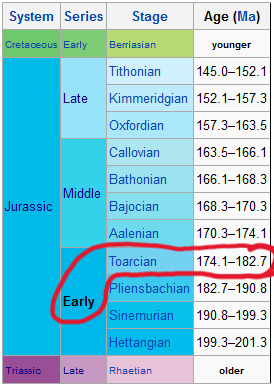#fossil shell Italy
Explore tagged Tumblr posts
Photo

Lytoceras adeloides Ammonite Fossil – Pliensbachian Jurassic Italy, Rare Authentic Specimen
A beautiful and rare example of Lytoceras adeloides, a distinctive ammonite fossil from the Pliensbachian Stage of the Lower Jurassic, approximately 190–192 million years ago. This specimen was collected from classic Jurassic deposits in Italy, a region known for its high-quality marine fossils.
Lytoceras ammonites are recognised for their smooth, involute coiling and finely ribbed or even nearly smooth shells, with wide umbilici and complex suture lines. L. adeloides is a rare and elegant representative of this genus and is especially sought after by collectors for its aesthetic structure and scientific interest.
Fossil Type: Ammonite (extinct marine cephalopod)
Species: Lytoceras adeloides
Geological Age: Lower Jurassic – Pliensbachian Stage
Formation: Likely part of Pliensbachian marine limestone or marl deposits of northern or central Italy
Depositional Environment: These ammonites lived in open marine environments, often deeper shelf settings, where sediments accumulated slowly. Preservation is generally excellent due to fine sediment and low disturbance.
Morphological Features:
Smooth, evolute shell with faint or absent ribbing
Wide umbilicus
Complex suture lines characteristic of Lytoceras
Coiling generally open and symmetrical
Notable:
Rare species from the Lytoceratidae family
Elegant appearance, ideal for fossil displays or academic collections
Sourced from Jurassic fossil beds of Italy
The specimen shown is the exact one you will receive
Authenticity: All of our fossils are 100% genuine natural specimens and come with a Certificate of Authenticity. Please refer to the included scale cube or ruler (1cm per square) for exact sizing.
This rare Lytoceras adeloides ammonite from the Pliensbachian of Italy is a fine example of early Jurassic cephalopods—elegant, scientifically relevant, and ideal for collectors seeking something special.
#Lytoceras adeloides#Jurassic ammonite fossil#Pliensbachian ammonite#Italian fossil ammonite#fossil cephalopod#Lytoceratidae fossil#spiral ammonite fossil#fossil shell Italy#Jurassic marine fossil#rare ammonite#authentic fossil specimen#collector ammonite
0 notes
Text

17th century altar base decorated with sea fans, barnacles and fossil shells. Florence , Italy
5 notes
·
View notes
Text
Sainte Marie Mineral Show Finds 2024 Complete List
To claim an item, please comment on the individual post. The complete rules can be found here. Please be sure to read the rules before claiming :)
Preview Items:
Amethyst Stalactite Specimen on Stand
Blueberry Fluorite on Quartz Specimen
Fluorite on Calcite Specimens
July 5th - 7th Sale:
Pink Opal Palm Stones
Bolivianite Palm Stones
Rhodochrosite Palm Stones
UV Reactive Calcite Specimens
Polished Malachite w Chrysocolla - Sold Out!
Polished Tourmalinated Natural Citrine
Rare Opalized Fluorite from Russia
Harlequin Jade from Italy
Scenic Quartz Round Gems
Rare Natural Citrine from Mexico
Amethyst Crystal Shards
Ocean Jasper Bowls - Sold Out!
Blue Calcite Starfish from Argentina
High-Grade Blue Calcite Palm Stones from Argentina
Phantom Amethyst Spheres
Tumbled Agate from Bulgaria - Sold Out!
Blue Barite Specimens from Spain
Epidote Clusters from Turkey
"Forest Quartz" from Turkey
Sparkly Grape Agate Clusters
Trolleite Hearts - Sold Out!
High-Grade Black Tourmaline Crystals
Cobaltoan Calcite from Morocco
Fossilized Snail Shells from Hungary
Sterling Silver Meteorite & Libyan Desert Glass Pendants
Sterling Silver Meterotie & Moldavite Pendants
Moldavite Cabochons - Sold Out!
Moldavite Adjustable Bracelets
Chrysocolla Freeforms from Peru
Charoite Slabs - Sold Out!
Natural Citrine Facets from Madagascar
Sphalerite Facets from Spain - Sold Out!
Harlequin Quartz Facets from Madagascar
Natural Smoky Ametrine Cabochons from Brazil
Unique Included Quartz Cabochons/Gems
Sparkly Agate Druzy Points
Large Trolleite Obelisks
Large Purple Labradorite Crescent Moons - Sold Out!
Pink/Red Chalcedony Geodes from Morocco
Large Prehnite Clusters from Morocco
New Find "Agathyst" Flames from Brazil
Amethyst & Calcite Specimens from Uruguay w Metal Stands
Thank you so much! I will periodically update the list with sold out items.
44 notes
·
View notes
Text




The Scottish Polymath Mary Somerville died on November 28th 1872 in Naples.
Today Somerville’s name lives on in an Oxford college, but her wider legacy is largely forgotten. She is the face of the Royal Bank of Scotland’s £10 banknote – the first non-royal woman to be honoured in this way.
Born in Mary Fairfax, Jedburgh on 26th December, 1790, Somerville grew up in the Fife seaside town of Burntisland. She was fascinated by the natural world from the start, collecting shells and fossils, and observing birds and sea creatures.
When her father returned from the sea, he discovered 8- or 9-year-old Mary could neither read nor do simple sums. He sent her to an elite boarding school, across the Firth of Forth, Miss Primrose's School in Musselburgh.
Miss Primrose was not a good experience for Mary and she was sent home in just a year. She began to educate herself, taking music and painting lessons, instructions in handwriting and arithmetic. She learned to read French, Latin, and Greek largely on her own. At age 15, Mary noticed some algebraic formulas used as decoration in a fashion magazine, and on her own she began to study algebra to make sense of them. She surreptitiously obtained a copy of Euclid's "Elements of Geometry" over her parents' opposition.
Four years after marrying, Mary Somerville and her family moved to London. Their social circle included the leading scientific and literary lights of the day, including Ada Bryon and her mother Maria Edgeworth, George Airy, John and William Herschel, George Peacock, and Charles Babbage. Mary and William had three daughters and a son who died in infancy. They also traveled extensively in Europe.
In 1826, Somerville began publishing papers on scientific subjects based on her own research. After 1831, she began writing about the ideas and work of other scientists as well. One book, "The Connection of the Physical Sciences," contained discussion of a hypothetical planet that might be affecting the orbit of Uranus. That prompted John Couch Adams to search for the planet Neptune, for which is he is credited as a co-discoverer.
Mary Somerville's translation and expansion of Pierre Laplace's "Celestial Mechanics" in 1831 won her acclaim and success: that same year, British prime minister Robert Peel awarded her a civil pension of 200 pounds annually. In 1833, Somerville and Caroline Herschel were named honorary members of the Royal Astronomical Society, the first time women had earned that recognition. Prime Minister Melbourne increased her salary to 300 pounds in 1837. William Somerville's health deteriorated and in 1838 the couple moved to Naples, Italy. She stayed there most of the remainder of her life, working and publishing.
In 1848, Mary Somerville published "Physical Geography," a book used for 50 years in schools and universities; although at the same time, it attracted a sermon against it in York Cathedral.
William Somerville died in 1860. In 1869, Mary Somerville published yet another major work, was awarded a gold medal from the Royal Geographical Society, and was elected to the American Philosophical Society.
By 1871, Mary Somerville had outlived her husbands, a daughter, and all of her sons: she wrote, "Few of my early friends now remain—I am nearly left alone." Mary Somerville died in Naples on November 29, 1872, just before turning 92. She had been working on another mathematical article at the time and regularly read about higher algebra and solved problems each day.
Her daughter published "Personal Recollections of Mary Somerville" the next year, parts of a work which Mary Somerville had completed most of before her death.
16 notes
·
View notes
Text
SandWing Names - Letter A
Aardvark (A type of nocturnal burrowing mammal with long snouts.) Aardwolf (A kind of hyena.) Aarush (Hindi word that means “first ray of sun.”) Abalos (A dune field on Mars. Also good for a NightWing hybrid.) Acacia (A genus of trees.) Accona (A desert in Italy.) Acinonyx (The genus the cheetah belongs to.) Adder (A kind of viper.) Adenium (Also known as the desert rose. A type of flower.) Adobe (A kind of clay used as a building material, typically in the form of sun-dried bricks. Also good for a MudWing hybrid.) Adust (Scorched or burned.) Aeonium (Plants that grow in warm, dry climates.) Aesculapian (A type of non venomous snake.) Agamidae (A family of iguanian lizards.) Agosto (Spanish for 'august'.) Agua (Spanish for 'water'.) Aker (The ancient Egyptian personification of the horizon.) Alectrona (The Greek goddess of the sunrise.) Alhagi (Also known as Camelthorns. A type of desert shrub.) Alluaudia (A type of succulent native to Madagascar.) Almond (The seed of the almond tree.) Aloe / Aloe Vera (A type of succulent that primarily grows in arid climates.) Anteater (Toothless insect eating mammals with long tongues.) Arroyo (A steep-sided gully formed by the action of fast-flowing water in an arid or semi-arid region.) Argali (Also known as the mountain sheep.) Antelope (A genus of hoofed mammals in the Bovidae family.) Aspidis (Latin for 'cobra'.) Anthill (A nest in the form of a mound built by ants or termites.) Ari (Hebrew for “lion.") Ash (The powdery substance that remains after something burns.) Arid (A land or climate that has little to no rain and is extremely dry.) Antlion (Insects primarily found in sandy regions. The larva commonly trap small insects in pits they've dug in the ground.) Aridisol (Arid soil.) Anhur (An Egyptian god of war.) Anubis (The Egyptian god of the dead.) Amargosa (A desert along the California-Nevada border.) Ankh (An ancient Egyptian symbol that represents life.) Anopheles (A genus of mosquitos.) Amaterasu (Japanese goddess of the sun.) Arenaceous (Consisting of sand particles., or animals and plants living or growing in sand.) Ariocarpus (A type of succulent.) Amber (A hard and translucent fossilized resin, or a yellow/orange color.) Armadillo (Mammals with unique shells, also known for digging.) Apophis (Ancient Egyptian god of chaos.) Ant (Insects that live in colonies.) Atacama (A desert in Chile.) August (The last summer month.) Aureate (Denoting, made of, or the color of gold.) Aurum (The Latin word for gold and source of its chemical symbol.) Axlewood (A tree native to India.)
#wings of fire#wof#wings of fire names#wof names#sandwing#sandwing names#a names#mammal names#names in other languages#location names#desert names#reptile names#snake names#tree names#yellow color names#god/goddess names#plant names#insect names#landscape names
6 notes
·
View notes
Text
The arc of justice finally bends against Big Oil
Sabrina Haake
April 14, 2024 6:15AM ET

An oil refinery blow off stack is seen, Sept. 16, 2008, in Texas City, Texas. (Photo by Mark Wilson/Getty Images)
This article was paid for by Raw Story subscribers. Not a subscriber? Try us and go ad-free for $1. Prefer to give a one-time tip? Click here.
In an historic ruling that could change the trajectory of a rapidly heating planet, a court of law with binding jurisdiction over most of Europe has ruled that governments can be held liable for inadequate responses to climate change.
The European Court of Human Rights determined that rising temperatures in Switzerland caused direct and tangible health consequences among Swiss citizens, and that governments failing to take adequate steps to mitigate and reduce greenhouse gas emissions could owe damages to people hurt by their inaction.
So what, in practical terms, does this mean for a planet that is literally burning in an increasing number of locations?
Europe could take climate cases in a new direction
The ECHR ruling is unprecedented in several respects, beginning with its reliance on principles of human rights.
The Court ruled that governments failing to do enough to address climate change were violating the European Convention on Human Rights, which holds as its first tenet that, “Everyone’s right to life shall be protected by law.” By failing to meet its own climate goals, the court held, the Swiss government impaired citizens’ fundamental rights to life.
The plaintiffs themselves were also unique. In climate cases pending around the world, including in the United States, the vast majority of plaintiffs are young people worried about how they will survive on a sweltering planet with rapidly disappearing habitats and resources.
ALSO READ: 15 worthless things Trump will give you for your money
The ECHR case, in contrast, was brought by elderly plaintiffs, most of whom were women in their 70s who proved that their age and gender make them particularly vulnerable to health risks linked to climate change. Heatwaves, in particular, can be deadly for the elderly as excessive heat triggers a strained cardiovascular response. Cognizant of their own time limitations, these women sued to benefit the next generation. One plaintiff told the BBC, “We know statistically that in 10 years we will be gone. So whatever we do now, we are not doing for ourselves, but for the sake of our children and our children's children.”
Because there is no avenue for appeal, the ECHR ruling will directly influence energy policy throughout the industrialized economies of Europe. Although it falls to Switzerland to comply with the ruling, its precedent is legally binding on all 46 member states, including Germany, the U.K., France and Italy — all fuel-burning heavy hitters.
Climate challenges in the U.S.
The European Court ruled that Switzerland’s efforts to reduce carbon emissions had been “woefully inadequate.” Although the ruling isn’t binding on U.S. courts, the domestic fossil fuel industry will be directly affected by it, since the U.S. has recently become the biggest supplier of crude oil to the European Union.
ALSO READ: Revealed: What government officials privately shared about Trump not disclosing finances
Climate litigants in the U.S. follow a different strategy. State and local governments are now suing fossil fuel companies and the American Petroleum Institute for damages caused by climate change — astronomical damages that inevitably fall to states, cities and towns that can’t afford to pay for them.
These climate cases name private fossil fuel companies as defendants, seeking to hold responsible various for-profit companies, including BP, Chevron, ConocoPhillips, ExxonMobil and Shell, for increasing carbon dioxide and methane emissions caused by their products.
Big Oil’s campaign of deception
Legal claims and allegations pending in the U.S. focus largely on Big Oil’s deceptive practices. Like the tobacco disinformation cases from the 1990s, these cases allege fraud, nuisance, conspiracy and negligence arising from the industry’s long-standing public disinformation campaigns.
Congress has conducted numerous investigations into Big Oil’s pattern of deception. Despite conclusive evidence that oil executives have long known the causal connection between fossil fuels and climate change, industry executives have consistently lied about it to protect their profits.
Nearly 10 years ago, Democratic members of Congress addressed a report by the Union of Concerned Scientists concluding that “there was a coordinated campaign of deception” on climate science by ExxonMobil, Chevron, ConocoPhillips, BP, Shell, Peabody Energy and other members of the fossil fuel industry.

Tanker drivers working for Shell in Grangemouth, Scotland. (Photo by Jeff J Mitchell/Getty Images)
Big Oil’s targeted acts of deception over a decades-long campaign included “forged letters to Congress,” secret funding of allegedly independent but industry-controlled scientists, creating “fake grassroots organizations” to influence policy, and multiple, ongoing, and in-depth “efforts to deliberately manufacture uncertainty about climate science.”
Evidence of the industry’s deceptive practices could be pivotal in cases brought by state and local governments paying a staggering tab for intensifying storms, flooding, crop-destroying droughts, extreme heat events and, for states and towns on major bodies of water, coastal erosion.
In the meantime, the fossil fuel industry continues to profit outrageously from extracting, distributing and marketing dangerous products known to increase Earth’s already feverish temperature: March was the 10th month in a row to set a new monthly global heat record, both on land and in the oceans, as global reliance on coal — the dirtiest fossil fuel of all — continues to climb.
Landmark climate cases in Montana, Hawaii
The ECHR decision was the first to rule that governments are obligated under human rights laws to address climate change, but it won’t be the last. Cases pending in Montana and Hawaii also allege damages from unmet climate obligations by their respective state governments.
Last August, 16 young plaintiffs scored an unprecedented victory in Montana. They argued that the state violated a state constitutional provision that guarantees Montana citizens a healthy environment, and Judge Kathy Seeley agreed. She ruled that permitting coal, oil and gas production worsened the climate crisis, in violation of the “healthy environment” guarantees found in the Montana constitution.
In result, state regulators issuing permits for fossil fuel developments must now consider the effects of greenhouse gas emissions as part of their overall analysis of whether to grant or deny the permit. After the state appealed the maverick ruling, Montana’s Supreme Court, in a 5-2 decision, denied the governor’s request to block the ruling pending appeal.
In Hawaii, another pending climate case involves 14 youths. Plaintiffs in Hawaii allege that the state’s transportation department, by funding highway projects that increase fuel consumption and greenhouse gas emissions, violated a constitutional duty to protect the environment.

A protestor holds a 'Polluters Pay Up' sign outside the Phillips 66 Los Angeles Refinery Wilmington Plant on Nov. 28, 2022, in Wilmington, Calif. (Photo by Mario Tama/Getty Images)
After the state challenged plaintiffs’ standing, claiming they could not show particularized harm because climate damages are already “baked in,” the judge ruled that climate damages to plaintiffs “are not hypothetical,” and allowed the case to proceed.
When the state asked Hawaii’s legislators for more than $2 million to hire outside counsel to fight the case, one state legislator told Hawaii Public Radio that instead of “spending the millions of dollars we’re spending on some hotshot law firm,” Hawaii should apply that money toward emissions reductions instead.
The case was scheduled for trial this summer, but in February, the fossil fuel defendants petitioned the U.S. Supreme Court, claiming that federal law precludes damages claims against them.
Take heart, then take action
Climate activists should be uplifted and encouraged by the ECHR decision, particularly as its effects begin to ripple through the fossil fuel industry, industrialized economies and reluctant courts.
It won’t change the prognosis or the immediate future — today’s youth throughout the world will still live through the worst effects of climate destruction, even though they had nothing to do with the policies that caused it.
It’s the same lament heard from emerging economies in Asia and Africa. Struggling countries and coastal populations who had nothing to do with industrialization over the past 150 years are now paying the steepest price through their own rapidly disappearing habitats.

Thousands of school students join protesters in a Climate strike rally on September 20, 2019, in Sydney, Australia. (Photo by Mark Evans/Getty Images)
But one major, outcome-determinative difference between these two rightfully aggrieved populations remains: the right to vote.
As enraging as it is for young Americans to hear oil-financed politicians deny climate change (“Drill baby, drill!”), we could fund the transition to clean energy — including an upgraded, nationwide grid of sufficient capacity — if every young adult simply voted.
Sabrina Haake is a columnist and 25 year litigator specializing in 1st and 14th Amendment defense. Follow her on Substack.
12 notes
·
View notes
Text
New Yorkers, beware the law of unintended consequences.
From an item at the New York Post comes the news that Kathy Hochul has just signed a new bill, “modeled after a federal law that holds polluters responsible for abandoned toxic-waste sites,” which establishes the New York Climate Superfund. This endowment will be funded by energy companies that deal in gas, oil, and coal, and the money will finance “resiliency projects,” like initiatives to shore up the coast and mitigate flooding—because obviously as every progressive and mainstream media consumer “knows,” energy that comes from “fossil fuels” cause “climate change.”
As of now, a number of companies operating in New York have been hit with $75 billion in fines, which are to be paid into the fund over the span of a decade. Per the NY Post:
The oil giant Saudi Aramco of Saudi Arabia could be slapped with the largest annual assessment of any company — $640 million a year — for emitting 31,269 million tons of greenhouse gases from 2000 to 2020. Aramco — formally known as the Saudi Arabian Oil Co. — is owned by the Saudi Royal family. The state-owned Mexican oil firm Petróleos Mexicanos, or Pemex, emitted 9,512 tons of CO2 and could face an $193 million assessment for generating 9,512 million tons of greenhouse gases. Russia’s Lukoil could be assessed with a $100 million yearly fee for spewing 4,912 millions of CO2. The 38 companies identified as carbon polluters include American petro giants such as Exxon and Chevron as well as Shell and BP in the UK, Total Energies IES in France, Petrobras in Brazil, BHP in Australia, Glencore in Switzerland, Equinor in Norway and ENI in Italy.
3 notes
·
View notes
Text
MERRY CHRISTMAS: HAVE A MOLLUSC!

Hope everyone is having a good Christmas! I can now sketch and paint dinosaurs to my heart's content!
Last Monday of the month so last Monday's Mollusc of the month (and year for that matter).

Dactylioceras is a genus of ammonite from the lower Jurassic Period around 180 Ma.

It's name means "horned finger" in reference to the branching ribs on its shell.

They are roughly 2.6 inches across and found in multiple countries across the northern hemisphere including the U.S., Canada, the U.K., France, Italy, Russia, Serbia and even Montenegro.
They are thought to have been scavengers on the sea floor who swam pretty slow.

Mass mortality assemblages are common so scientists think they might have died shortly after spawning.

There are currently 3-4 accepted subgenera and at least 58 accepted species of Dactylioceras. It is a widely used index fossil for biostratigraphy.

7 notes
·
View notes
Text
From Peasant Fodder To Posh Fare: How Snails And Oysters Became Luxury Foods
— Beth Daley | The Conversation | May 22, 2025

An Oyster cellar in Leith. John Burnet, 1819; National Galleries of Scotland, Photo: Antonia Reeve
Oysters and escargot are recognised as luxury foods around the world – but they were once valued by the lower classes as cheap sources of protein. Less adventurous eaters today see snails as a garden pest, and are quick to point out that freshly shucked oysters are not only raw but also alive when they are eaten. How did these unusual ingredients become items of conspicuous consumption?
From Garden Snail To Gastronomy
Eating what many consider to be a slimy nuisance seems almost counter-intuitive, but consuming land snails has an ancient history, dating to the Palaeolithic period, some 30,000 years ago in eastern Spain. Ancient Romans also dined on snails, and spread their eating habits across their empire into Europe. Lower and middle class Romans ate snails from their gardens, while elite consumers ate specially farmed snails, fed spices, honey and milk.

An Ancient Roman mosaic dating to the 4th century AD depicting a basket of snails, Basilica di Santa Maria Assunta, Aquileia, Italy. Carole Raddato/Wikimedia Commons, CC BY-SA
Pliny the Elder (AD 24–79) described how snails were raised in ponds and given wine to fatten them up. The first French recipe for snails appears in 1390, in Le Ménagier de Paris (The Good Wife’s Guide), but not in other cookbooks from the period.
In 1530, a French treatise on frogs, snails, turtles and artichokes considered all these foods bizarre, but surprisingly popular. Some of the appeal had to do with avoiding meat on “lean” days. Snails were classified as fish by the Catholic Church, and could even be eaten during Lent.
For the next 200 years, snails only appeared in Parisian cookbooks with an apology for including such a disgusting ingredient. This reflected the taste of upper-class urbanites, but snails were still eaten in the eastern provinces.

Schneckenweib, or Snail Seller, illustrated by Johann Christian Brand in Vienna, after 1798. Wien Museum
An 1811 cookbook from Metz, in the Alsace region in northeastern France, describes raising snails like the Romans, and a special platter, l'escargotière, for serving them. The trend did not travel to Paris until after 1814.
French diplomat Charles-Maurice de Talleyrand-Périgord (1754–1838) hosted a dinner for Russian Tsar Alexander I, after he marched into Paris following the allied forces’ defeat of Napoleon in 1814. The chef catering the meal was the father of French cuisine Marie-Antoine Carême, a native of Burgundy, spiritual home of the now famous escargots de Bourgogne.
Carême served the Tsar what would become a classic recipe, prepared with garlic, parsley and butter. Allegedly, the Tsar raved about the “new” dish, and snails became wildly popular. A recipe for Burgundy snails first appeared in a French culinary dictionary published in 1825.
It is ironic that it took the approval of a foreign emperor, who had just conquered Napoleon, to restore luxury status to escargot, a food that became a symbol of French cuisine. Snails remain popular today in France, with consumption peaking during the Christmas holidays, but May 24 is National Escargot Day in France.
Oysters: The Original Fast Food
Oysters are another ancient food, as seen in fossils dating to the Triassic Era, 200 million years ago. Evidence of fossilised oysters are found on every major land mass, and there is evidence of Indigenous oyster fisheries in North America and Australia that dates to the Holocene period, about 12,000 years ago.
There are references in classical Greek texts to what are probably oysters, by authors like Aristotle and Homer. Oyster shells found at Troy confirm they were a favoured food. Traditionally served as a first course at banquets in Ancient Greece, they were often cooked, sometimes with exotic spices.

Music-cover sheet for ‘Bonne-Bouche’ by Emile Waldteufel, 1847-1897. © The Trustees of the British Museum, CC BY-NC-SA
Pliny the Elder refers to oysters as a Roman delicacy. He recorded methods of the pioneer of Roman oyster farming, Sergius Orata, who brought the best specimens from across the Empire to sell to elite customers.
Medieval coastal dwellers gathered oysters at low tide, while wealthy inland consumers would have paid a premium for shellfish, a perishable luxury, transported to their castles.
French nobles in 1390 preferred cooked oysters, roasted over coals or poached in broths, perhaps as a measure to prevent food poisoning. As late as the 17th century, authors cautioned:
But if they be eaten raw, they require good wine […] to aid digestion.

Oyster Seller, Jacob Gole, 1688–1724. Rijksmuseum
By the 18th century, small oysters were a popular pub snack, and larger ones were added as meat to the stew pot. That century, it is believed as many as 100,000 oysters were eaten each day in Edinburgh and the shells from the tavern in the basement filled in gaps in the brickwork at Gladstone’s Land in Edinburgh’s Royal Mile.
Scottish oyster farms in the Firth of Forth, an inlet of the North Sea, produced 30 million oysters in 1790, but continual over-harvesting took its toll. By 1883 only 6,000 oysters were landed, and the population was declared extinct in 1957.
As wild oyster stocks dwindled, large oyster farms developed in cities like New York in the 19th century. Initially successful, they were polluted, and infected by typhoid from sewage. An outbreak in 1924 killed 150 people, the deadliest food poisoning in United States history.

Costumes of Naples: Oyster Sellers, c. 1906–10. Rijksmuseum
Far from the overabundance of oysters we once had, over-fishing, pollution, and invasive species all threaten oyster populations worldwide today. Due to this scarcity of wild oysters and the resources required to safely farm environmentally sustainable oysters, they are now a premium product.
Next On The Menu
Scarcity made oysters a luxury, and a Tsar’s approval elevated snails to gourmet status. Could insects become the next status food? Ancient Romans ate beetles and grasshoppers, and cultures around the world consume insects, but not (yet) as luxury products. Maybe the right influencer can make honey-roasted locust the next species to jump from paddock to plate.
#TheConversation.Com#Beth Daley | Executive Editor ✍️ | General Manager#Peasant Fodder#Posh Fare#Snails 🐌🐌🐌#Oysters 🦪🦪🦪#History#Food 🍲🍱🥘#Food History
0 notes
Text
Alternative Fuel Vehicles Market Size, Analyzing Trends and Projected Outlook for 2025-2032

Fortune Business Insights released the Global Alternative Fuel Vehicles Market Trends Study, a comprehensive analysis of the market that spans more than 150+ pages and describes the product and industry scope as well as the market prognosis and status for 2025-2032. The marketization process is being accelerated by the market study's segmentation by important regions. The market is currently expanding its reach.
The Alternative Fuel Vehicles Market is experiencing robust growth driven by the expanding globally. The Alternative Fuel Vehicles Market is poised for substantial growth as manufacturers across various industries embrace automation to enhance productivity, quality, and agility in their production processes. Alternative Fuel Vehicles Market leverage robotics, machine vision, and advanced control technologies to streamline assembly tasks, reduce labor costs, and minimize errors. With increasing demand for customized products, shorter product lifecycles, and labor shortages, there is a growing need for flexible and scalable automation solutions. As technology advances and automation becomes more accessible, the adoption of automated assembly systems is expected to accelerate, driving market growth and innovation in manufacturing.
The global alternative fuel vehicles market size was USD 293.45 billion in 2020. The global impact of novel coronavirus disease 2019 has been unprecedented and staggering, with alternative fuel vehicles witnessing a positive impact on demand across all regions amid the COVID-19 crisis. Based on our analysis, the global market will exhibit a stellar growth of 25.6% in 2020. The market is projected to grow from USD 330.45 billion in 2021 to USD 1,681.80 billion by 2028, exhibiting a Compound Annual Growth Rate (CAGR) of 26.2% during the forecast period.
Get Sample PDF Report: https://www.fortunebusinessinsights.com/enquiry/request-sample-pdf/102518
Major Alternative Fuel Vehicles Market Manufacturers covered in the market report include:
LIST OF KEY COMPANIES PROFILED:
Honda Motor Co., Ltd. (Tokyo, Japan)
Toyota Motor Corporation (Aichi, Japan)
Nissan Motor Corporation (Yokohama, Kanagawa, Japan)
Daimler AG (Stuttgart, Germany)
Tesla (California, U.S.)
BYD Company Ltd. (Shenzhen, China)
Ford Motor Company (Michigan, U.S.)
MITSUBISHI MOTORS CORPORATION. (Tokyo, Japan)
SHELL International B.V. (Hague, Netherlands)
JAGUAR LAND ROVER AUTOMOTIVE PLC (Coventry, U.K.)
Rising fossil fuel prices such as gasoline & diesel and heavy dependence on foreign countries to import fossil fuels significantly increase the pressure on the emerging economies worldwide, resulting in a boost in demand for AFVs. According to the U.S. Energy Information Administration, in November 2020, Brent crude oil prices averaged USD 43 per barrel, increasing significantly to an average price of USD 67 per barrel in March 2021 (One barrel contains 42 gallons). This increase in crude oil prices significantly affected the prices of petroleum products such as fossil fuels.
Geographically, the detailed analysis of consumption, revenue, market share, and growth rate of the following regions:
The Middle East and Africa (South Africa, Saudi Arabia, UAE, Israel, Egypt, etc.)
North America (United States, Mexico & Canada)
South America (Brazil, Venezuela, Argentina, Ecuador, Peru, Colombia, etc.)
Europe (Turkey, Spain, Turkey, Netherlands Denmark, Belgium, Switzerland, Germany, Russia UK, Italy, France, etc.)
Asia-Pacific (Taiwan, Hong Kong, Singapore, Vietnam, China, Malaysia, Japan, Philippines, Korea, Thailand, India, Indonesia, and Australia).
Alternative Fuel Vehicles Market Research Objectives:
- Focuses on the key manufacturers, to define, pronounce and examine the value, sales volume, market share, market competition landscape, SWOT analysis, and development plans in the next few years.
- To share comprehensive information about the key factors influencing the growth of the market (opportunities, drivers, growth potential, industry-specific challenges and risks).
- To analyze the with respect to individual future prospects, growth trends and their involvement to the total market.
- To analyze reasonable developments such as agreements, expansions new product launches, and acquisitions in the market.
- To deliberately profile the key players and systematically examine their growth strategies.
Frequently Asked Questions (FAQs):
► What is the current market scenario?
► What was the historical demand scenario, and forecast outlook from 2025 to 2032?
► What are the key market dynamics influencing growth in the Global Alternative Fuel Vehicles Market?
► Who are the prominent players in the Global Alternative Fuel Vehicles Market?
► What is the consumer perspective in the Global Alternative Fuel Vehicles Market?
► What are the key demand-side and supply-side trends in the Global Alternative Fuel Vehicles Market?
► What are the largest and the fastest-growing geographies?
► Which segment dominated and which segment is expected to grow fastest?
► What was the COVID-19 impact on the Global Alternative Fuel Vehicles Market?
FIVE FORCES & PESTLE ANALYSIS:
In order to better understand market conditions five forces analysis is conducted that includes the Bargaining power of buyers, Bargaining power of suppliers, Threat of new entrants, Threat of substitutes, and Threat of rivalry.
Political (Political policy and stability as well as trade, fiscal, and taxation policies)
Economical (Interest rates, employment or unemployment rates, raw material costs, and foreign exchange rates)
Social (Changing family demographics, education levels, cultural trends, attitude changes, and changes in lifestyles)
Technological (Changes in digital or mobile technology, automation, research, and development)
Legal (Employment legislation, consumer law, health, and safety, international as well as trade regulation and restrictions)
Environmental (Climate, recycling procedures, carbon footprint, waste disposal, and sustainability)
Points Covered in Table of Content of Global Alternative Fuel Vehicles Market:
Chapter 01 - Alternative Fuel Vehicles Market for Automotive Executive Summary
Chapter 02 - Market Overview
Chapter 03 - Key Success Factors
Chapter 04 - Global Alternative Fuel Vehicles Market - Pricing Analysis
Chapter 05 - Global Alternative Fuel Vehicles Market Background or History
Chapter 06 - Global Alternative Fuel Vehicles Market Segmentation (e.g. Type, Application)
Chapter 07 - Key and Emerging Countries Analysis Worldwide Alternative Fuel Vehicles Market.
Chapter 08 - Global Alternative Fuel Vehicles Market Structure & worth Analysis
Chapter 09 - Global Alternative Fuel Vehicles Market Competitive Analysis & Challenges
Chapter 10 - Assumptions and Acronyms
Chapter 11 - Alternative Fuel Vehicles Market Research Methodology
About Us:
Fortune Business Insights™ delivers accurate data and innovative corporate analysis, helping organizations of all sizes make appropriate decisions. We tailor novel solutions for our clients, assisting them to address various challenges distinct to their businesses. Our aim is to empower them with holistic market intelligence, providing a granular overview of the market they are operating in.
Contact Us:
Fortune Business Insights™ Pvt. Ltd.
US:+18339092966
UK: +448085020280
APAC: +91 744 740 1245
0 notes
Text
2025-2031: Carbon Capture and Storage Market Size And Forecast
On 2025-2-10 Global Info Research��released【Global Carbon Capture and Storage Market 2025 by Manufacturers, Regions, Type and Application, Forecast to 2031】. This report includes an overview of the development of the Carbon Capture and Storage industry chain, the market status of Consumer Electronics (Nickel-Zinc Ferrite Core, Mn-Zn Ferrite Core), Household Appliances (Nickel-Zinc Ferrite Core, Mn-Zn Ferrite Core), and key enterprises in developed and developing market, and analysed the cutting-edge technology, patent, hot applications and market trends of Carbon Capture and Storage. According to our (Global Info Research) latest study, the global Carbon Capture and Storage market size was valued at US$ 4550 million in 2024 and is forecast to a readjusted size of USD 6749 million by 2031 with a CAGR of 5.9% during review period.
Carbon capture and storage (CCS) (or carbon capture and sequestration or carbon control and sequestration) is the process of capturing waste carbon dioxide (CO2) from large point sources, such as fossil fuel power plants, transporting it to a storage site, and depositing it where it will not enter the atmosphere, normally an underground geological formation. The aim is to prevent the release of large quantities of CO2 into the atmosphere (from fossil fuel use in power generation and other industries). It is a potential means of mitigating the contribution of fossil fuel emissions to global warming and ocean acidification. Although CO2 has been injected into geological formations for several decades
for various purposes, including enhanced oil recovery, the long term storage of CO2 is a relatively new concept. The main Carbon Capture and Storage players include Exxonmobil Corporation, Schlumberger, Linde AG, Halliburton, etc. The top four Carbon Capture and Storage players account for approximately 35% of the total global market. America is the largest consumer market for Carbon Capture and Storage accounting for about 49%, followed by Asia Pacific and Europe. In terms of Type, S Post-Combustion Carbon Capture is the largest segment with a share of 83%. And in terms of Applications, the largest segment is Oil & Gas, followed by Power Generation.
This report is a detailed and comprehensive analysis for global Carbon Capture and Storage market. Both quantitative and qualitative analyses are presented by company, by region & country, by Type and by Application. As the market is constantly changing, this report explores the competition, supply and demand trends, as well as key factors that contribute to its changing demands across many markets. Company profiles and product examples of selected competitors, along with market share estimates of some of the selected leaders for the year 2025, are provided. Market segment by Type: Pre-Combustion Carbon Capture、Oxy-Combustion Carbon Capture、Post-Combustion Carbon Capture Market segment by Application:Oil & Gas、Power Generation、Others Major players covered: Exxonmobil Corporation、Schlumberger、Huaneng、Linde AG、Halliburton、BASF、General Electric、Siemens、Honeywell UOP、Sulzer、Equinor、NRG、AkerSolutions、Shell、Skyonic Corp.、Mitsubishi Hitachi、Fluor、Sinopec
Market segment by region, regional analysis covers: North America (United States, Canada and Mexico), Europe (Germany, France, United Kingdom, Russia, Italy, and Rest of Europe), Asia-Pacific (China, Japan, Korea, India, Southeast Asia, and Australia),South America (Brazil, Argentina, Colombia, and Rest of South America),Middle East & Africa (Saudi Arabia, UAE, Egypt, South Africa, and Rest of Middle East & Africa). The content of the study subjects, includes a total of 15 chapters: Chapter 1, to describe Carbon Capture and Storage product scope, market overview, market estimation caveats and base year. Chapter 2, to profile the top manufacturers of Carbon Capture and Storage, with price, sales, revenue and global market share of Carbon Capture and Storage from 2020 to 2025. Chapter 3, the Carbon Capture and Storage competitive situation, sales quantity, revenue and global market share of top manufacturers are analyzed emphatically by landscape contrast. Chapter 4, the Carbon Capture and Storage breakdown data are shown at the regional level, to show the sales quantity, consumption value and growth by regions, from 2020 to 2031. Chapter 5 and 6, to segment the sales by Type and application, with sales market share and growth rate by type, application, from 2020 to 2031. Chapter 7, 8, 9, 10 and 11, to break the sales data at the country level, with sales quantity, consumption value and market share for key countries in the world, from 2020 to 2024.and Carbon Capture and Storage market forecast, by regions, type and application, with sales and revenue, from 2025 to 2031. Chapter 12, market dynamics, drivers, restraints, trends and Porters Five Forces analysis. Chapter 13, the key raw materials and key suppliers, and industry chain of Carbon Capture and Storage. Chapter 14 and 15, to describe Carbon Capture and Storage sales channel, distributors, customers, research findings and conclusion.
Data Sources:
Via authorized organizations:customs statistics, industrial associations, relevant international societies, and academic publications etc.
Via trusted Internet sources.Such as industry news, publications on this industry, annual reports of public companies, Bloomberg Business, Wind Info, Hoovers, Factiva (Dow Jones & Company), Trading Economics, News Network, Statista, Federal Reserve Economic Data, BIS Statistics, ICIS, Companies House Documentsm, investor presentations, SEC filings of companies, etc.
Via interviews. Our interviewees includes manufacturers, related companies, industry experts, distributors, business (sales) staff, directors, CEO, marketing executives, executives from related industries/organizations, customers and raw material suppliers to obtain the latest information on the primary market;
Via data exchange. We have been consulting in this industry for 16 years and have collaborations with the players in this field. Thus, we get access to (part of) their unpublished data, by exchanging with them the data we have.
From our partners.We have information agencies as partners and they are located worldwide, thus we get (or purchase) the latest data from them.
Via our long-term tracking and gathering of data from this industry.We have a database that contains history data regarding the market.
Global Info Research is a company that digs deep into global industry information to support enterprises with market strategies and in-depth market development analysis reports. We provides market information consulting services in the global region to support enterprise strategic planning and official information reporting, and focuses on customized research, management consulting, IPO consulting, industry chain research, database and top industry services. At the same time, Global Info Research is also a report publisher, a customer and an interest-based suppliers, and is trusted by more than 30,000 companies around the world. We will always carry out all aspects of our business with excellent expertise and experience.
0 notes
Text
Meticulous Research®, a prominent global market research firm, has released an in-depth analysis titled, "Hydrogen Generation Market by Type (Gray, Green, Blue), Process (Hydrogen Generation, Hydrogen Storage), Source (Fossil Fuels, Nuclear, Solar), Application (Ammonia Production, Petroleum Refinery, E-mobility, Power Generation) - Global Forecast to 2030."
According to this latest report, the global hydrogen generation market is projected to reach $188.2 billion by 2030, growing at a CAGR of 8.4% from 2023 to 2030. The market expansion is primarily driven by the surging demand for hydrogen within the chemicals sector and robust governmental initiatives promoting the shift towards clean energy. Despite the substantial capital costs associated with hydrogen storage, the market is set to grow due to the increasing focus on green hydrogen production technologies and the burgeoning use of hydrogen in fuel cell electric vehicles (FCEVs). However, challenges such as the lack of secure infrastructure for hydrogen transport and storage persist.
Download Free Sample Report Here: https://www.meticulousresearch.com/download-sample-report/cp_id=5600
Market Segmentation and Key Insights:
By Type: The market is segmented into gray hydrogen, blue hydrogen, green hydrogen, and others. In 2023, gray hydrogen is expected to dominate the market share, driven by its demand in fertilizer production and fuel applications. Meanwhile, green hydrogen is anticipated to exhibit the highest growth rate, attributed to advancements in electrolysis technologies and the rising demand in FCEVs and the power sector.
By Process: The segmentation includes hydrogen generation and hydrogen storage processes. The hydrogen generation segment is forecasted to lead, spurred by industrial demand and efforts to reduce greenhouse gas emissions through renewable energy sources and decarbonization technologies.
By Source: This includes fossil fuels, nuclear, water, solar, biomass, and others. The fossil fuels segment is set to hold the largest share in 2023 due to efforts in reducing emissions and government incentives. However, the solar segment is poised for the highest growth, propelled by the demand for green hydrogen and low-cost production methods.
By Application: The applications cover ammonia production, petroleum refinery, E-mobility, methanol production, district heating, power generation, manufacturing, and synfuel production. Ammonia production is projected to lead in 2023, driven by its use as a low-carbon fuel and in industry decarbonization. The E-mobility segment will grow the fastest due to the rising adoption of FCEVs and expanding hydrogen fueling infrastructure.
By Geography: The report covers North America, Europe, Asia-Pacific, Latin America, and the Middle East & Africa. Asia-Pacific is anticipated to dominate the market, followed by Europe and North America, due to the region’s commitment to carbon-free hydrogen production and renewable energy initiatives.
Quick Buy: https://www.meticulousresearch.com/Checkout/85905435
Key Market Players:
The leading companies in the hydrogen generation market include Plug Power Inc. (U.S.), Linde GmbH (Germany), Air Products and Chemicals, Inc. (U.S.), L’AIR LIQUIDE S.A. (France), Matheson Tri-Gas, Inc. (U.S.), SOL Spa (Italy), Cummins Inc. (U.S.), Siemens Energy AG (Germany), Shell plc (U.K.), Messer SE & Co. KGaA (Germany), Ballard Power Systems Inc. (Canada), FuelCell Energy, Inc. (U.S.), Iwatani Corporation (Japan), Enapter AG (Germany), CALORIC Anlagenbau GmbH (Germany), SPG Hydrogen Co., Ltd. (South Korea), Uniper SE (Germany), and Nel ASA (Norway).
Download the Sample Report Here: Sample Report
Key Questions Addressed:
What are the high-growth market segments by type, process, source, application, and geography?
How has the hydrogen generation market evolved historically, and what are the forecasts for 2023–2030?
What are the key drivers, restraints, opportunities, and challenges in the market?
Who are the major players, and what are their market shares?
What is the competitive landscape and recent developments in the hydrogen generation market?
What strategies are major players adopting to compete in the market?
What are the key geographic trends, and which countries exhibit high growth?
Contact Us:
Meticulous Research® Email: [email protected] Phone: +1-646-781-8004 Connect with us on LinkedIn
0 notes
Text
Shimmering Seaweeds and Algae Antennae: Sustainable Energy Solutions Under the Sea - Technology Org
New Post has been published on https://thedigitalinsider.com/shimmering-seaweeds-and-algae-antennae-sustainable-energy-solutions-under-the-sea-technology-org/
Shimmering Seaweeds and Algae Antennae: Sustainable Energy Solutions Under the Sea - Technology Org
How could tiny antennae attached to tiny algae speed up the transition away from fossil fuels? Cambridge researchers are studying this question as they search for new ways to decarbonise our energy supply and improve the sustainability of harmful materials such as paints and dyes.
Seaweeds showing structural colour. Credit: BEEP / Cambridge University
Funded by the European Union’s Horizon 2020 research and innovation programme, the Bio-inspired and Bionic materials for Enhanced Photosynthesis (BEEP) project, led by Professor Silvia Vignolini in the Yusuf Hamied Department of Chemistry, studied how marine organisms interact with light.
The four-year sustainable energy project brought together nine research groups from across Europe and drew its inspiration from nature, in particular from the marine world, where organisms including algae, corals and sea slugs have evolved efficient ways to convert sunlight into energy. Harnessing these properties could aid in the development of new artificial and bionic photosynthetic systems.
Some of the brightest and most colourful materials in nature – such as peacock feathers, butterfly wings and opals – get their colour not from pigments or dyes, but from their internal structure alone. The colours our eyes perceive originate from the interaction between light and nanostructures at the surface of the material, which reflect certain wavelengths of light.
As part of the BEEP project, the team studied structural colour in marine species. Some marine algae species have nanostructures in their cell walls that can transmit certain wavelengths of visible light or change their structures to guide the light inside the cell. Little is known about the function of these structures, however: scientists believe they might protect the organisms from UV light or optimise light harvesting capabilities.
The team studied the optical properties and light harvesting efficiency of a range of corals, sea-slugs, microalgae and seaweeds. By understanding the photonic and structural properties of these species, the scientists hope to design new materials for bio-photoreactors and bionic systems.
“We’re fascinated by the optical effects performed by these organisms,” said Maria Murace, a BEEP PhD candidate at Cambridge, who studies structural colour in seaweeds and marine bacteria. “We want to understand what the materials and the structures at the base of these colours are, which could lead to the development of green and sustainable alternatives to the conventional paints and toxic dyes we use today.”
BEEP also studied diatoms: tiny photosynthetic algae that live in almost every aquatic system on Earth and produce as much as half of the oxygen we breathe. The silica shells of these tiny algae form into stunning structures, but they also possess remarkable light-harvesting properties.
The BEEP team engineered tiny light-harvesting antennae and attached them to diatom shells. “These antennae allowed us to gather the light that would otherwise not be harvested by the organism, which is converted and used for photosynthesis,” said Cesar Vicente Garcia, one of the BEEP PhD students, from the University of Bari in Italy. “The result is promising: diatoms grow more! This research could inspire the design of powerful bio-photoreactors, or even better
The scientists engineered a prototype bio-photoreactor, consisting of a fully bio-compatible hydrogel which sustains the growth of microalgae and structural coloured bacteria. The interaction of these organisms is mutually beneficial, enhancing microalgal growth and increasing the volume of biomass produced, which could have applications in the biofuel production industry.
Alongside research, the network has organised several training and outreach activities, including talks and exhibitions for the public at science festivals in Italy, France and the UK.
“Society relies on science to drive growth and progress,” said Floriana Misceo, the BEEP network manager who coordinated outreach efforts. “It’s so important for scientists to share their research and help support informed discussion and debate because without it, misinformation can thrive, which is why training and outreach was an important part of this project.”
“Coordinating this project has been a great experience. I learned immensely from the other groups in BEEP and the young researchers,” said Vignolini. “The opportunity to host researchers from different disciplines in the lab was instrumental in developing new skills and approaching problems from a different perspective.”
Source: Cambridge University
You can offer your link to a page which is relevant to the topic of this post.
#algae#applications#artificial#Bacteria#biomass#butterfly#cell#change#chemistry#Chemistry & materials science news#colours#corals#Design#development#earth#effects#efficiency#energy#Energy & fuel news#Europe#european union#exhibitions#eyes#feathers#festivals#form#fossil#Fossil fuels#France#fuels
0 notes
Text
Industrial Wax Market Growth Prospects, Trends And Forecast Up To 2030
The “Global Industrial Wax Market 2030” is market research by The Insight Partners. The Industrial Wax market has witnessed tides of transformation in the recent past. This study offers precise projections after detailed scrutiny of a range of factors impacting the business. Considering the present market scenario, this report brings forward accurate projections on revenue, market size, and CAGR of the Industrial Wax market. The novel Industrial Wax market research which is based on fact-based foundation is now available for purchase. This market research can make a difference in wide decision-making and drive business forward in the right direction.
In a highly competitive Industrial Wax market, companies may face several challenges. It is no longer a game of intuitions when it comes to investing in new ventures. Having trusted market research is always recommended for both veteran and new entrants. Industrial Wax Market research brings you a complete analysis of regional, international, and local situations through the following chapters.
Market Analysis and Forecast
This chapter evaluates several factors that impact on business. The economics of scale described based on market size, growth rate, and CAGR are coupled with future projections of the Industrial Wax market. This chapter is further essential to analyze drivers of demand and restraints ahead of market participants. Understanding market trends helps companies to manage their products and position themselves in the market gap.
This section offers business environment analysis based on different models. Streamlining revenues and success is crucial for businesses to remain competitive in the Industrial Wax market. Companies can revise their unique selling points and map the economic, environmental, and regulatory aspects.
Covid-19 Analysis
Unprecedented COVID-19 crisis followed by temporary destruction of businesses. Industrial Wax Market players faced challenges to survive their production lifecycle, reduced revenues, and weak marketing performance. Small, and medium-sized companies struggled to manage expectations and hold on to supply-demand equilibrium. This section covers the impact analysis of COVID-19 on business and alternative ways used by businesses to respond to the pandemic-led disruptions. Post-Covid -19 recovery prospects are also covered in this chapter.
Market Segmentation
Industrial Wax market research report is segmented as follows.
Based on Type of Industrial Wax Market Research report:
Fossil Based Wax
Synthetic Based Wax
Bio-Based Wax
Based on Application of Industrial Wax Market Research report:
Candles
Packaging
Coatings and Polishes
Hot Melt Adhesives
Tires and Rubber
Cosmetics and Personal Care
Food
Others
Based on Regions:
North America (U.S., Canada, Mexico)
Europe (U.K., France, Germany, Spain, Italy, Central & Eastern Europe, CIS)
Asia Pacific (China, Japan, South Korea, ASEAN, India, Rest of Asia Pacific)
Latin America (Brazil, Rest of Latin America)
The Middle East and Africa (Turkey, GCC, Rest of the Middle East and Africa)
Rest of the World…
Competitive Landscape
The competitor's analysis offered in this report emphasizes covering key companies in the Industrial Wax market. A brief discussion of leading market players and their business strategies intends to offer essential details needed for a competitive edge.
Key companies in Industrial Wax market are:
China Petrochemical Corporation
Exxon Mobil Corporation
HCI wax
Numaligarh Refinery Limited
Petroleo Brasileiro S.A. (Petrobras)
PJSC LUKOIL
Sasol Limited
Shell International B.V.
The Blayson Group Ltd
The International Group, Inc.
Strategic Recommendations
Strategic planning is crucial for business success. This section offers strategic recommendations needed for businesses and investors. Forward forward-focused vision of a business is what makes it through thick and thin. Knowing business environment factors helps companies in making strategic moves at the right time in the right direction.
Summary:
Market Size & Forecast by Revenue | Forecast Year
Market Dynamics – Leading trends, growth drivers, restraints, and investment opportunities
Market Segmentation – A detailed analysis by product, types, end-user, applications, segments, and geography
Competitive Landscape – Top key vendors and other prominent vendors
0 notes
Photo


Nettuno, Italy
0 notes
Photo




The Scottish Polymath Mary Somerville died on November 28th 1872 in Naples.
Today Somerville’s name lives on in an Oxford college, but her wider legacy is largely forgotten. She is the face of the Royal Bank of Scotland’s £10 banknote – the first non-royal woman to be honoured in this way.
Born in Mary Fairfax, Jedburgh on 26th December, 1790, Somerville grew up in the Fife seaside town of Burntisland. She was fascinated by the natural world from the start, collecting shells and fossils, and observing birds and sea creatures.
When her father returned from the sea, he discovered 8- or 9-year-old Mary could neither read nor do simple sums. He sent her to an elite boarding school, across the Firth of Forth, Miss Primrose's School in Musselburgh.
Miss Primrose was not a good experience for Mary and she was sent home in just a year. She began to educate herself, taking music and painting lessons, instructions in handwriting and arithmetic. She learned to read French, Latin, and Greek largely on her own. At age 15, Mary noticed some algebraic formulas used as decoration in a fashion magazine, and on her own she began to study algebra to make sense of them. She surreptitiously obtained a copy of Euclid's "Elements of Geometry" over her parents' opposition.
Four years after marrying, Mary Somerville and her family moved to London. Their social circle included the leading scientific and literary lights of the day, including Ada Bryon and her mother Maria Edgeworth, George Airy, John and William Herschel, George Peacock, and Charles Babbage. Mary and William had three daughters and a son who died in infancy. They also traveled extensively in Europe.
In 1826, Somerville began publishing papers on scientific subjects based on her own research. After 1831, she began writing about the ideas and work of other scientists as well. One book, "The Connection of the Physical Sciences," contained discussion of a hypothetical planet that might be affecting the orbit of Uranus. That prompted John Couch Adams to search for the planet Neptune, for which is he is credited as a co-discoverer.
Mary Somerville's translation and expansion of Pierre Laplace's "Celestial Mechanics" in 1831 won her acclaim and success: that same year, British prime minister Robert Peel awarded her a civil pension of 200 pounds annually. In 1833, Somerville and Caroline Herschel were named honorary members of the Royal Astronomical Society, the first time women had earned that recognition. Prime Minister Melbourne increased her salary to 300 pounds in 1837. William Somerville's health deteriorated and in 1838 the couple moved to Naples, Italy. She stayed there most of the remainder of her life, working and publishing.
In 1848, Mary Somerville published "Physical Geography," a book used for 50 years in schools and universities; although at the same time, it attracted a sermon against it in York Cathedral.
William Somerville died in 1860. In 1869, Mary Somerville published yet another major work, was awarded a gold medal from the Royal Geographical Society, and was elected to the American Philosophical Society.
By 1871, Mary Somerville had outlived her husbands, a daughter, and all of her sons: she wrote, "Few of my early friends now remain—I am nearly left alone." Mary Somerville died in Naples on November 29, 1872, just before turning 92. She had been working on another mathematical article at the time and regularly read about higher algebra and solved problems each day.
Her daughter published "Personal Recollections of Mary Somerville" the next year, parts of a work which Mary Somerville had completed most of before her death.
40 notes
·
View notes